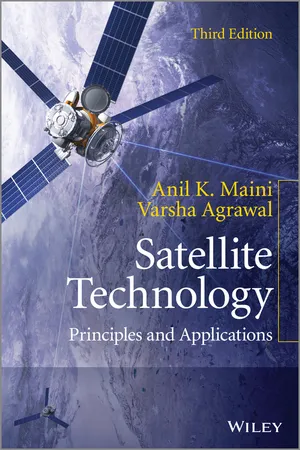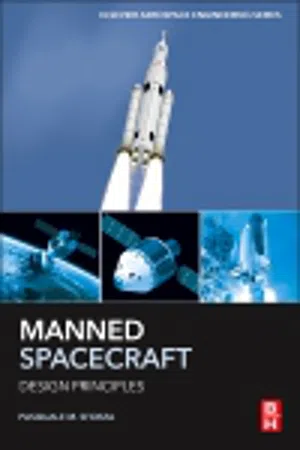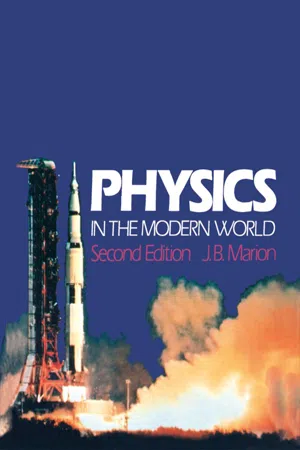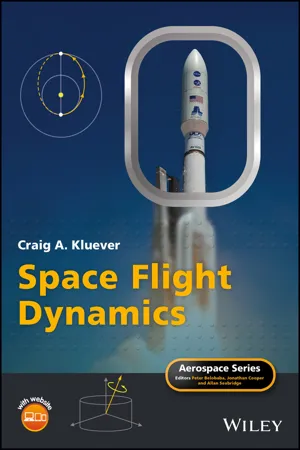Physics
Orbital Trajectory
An orbital trajectory refers to the path followed by an object as it moves around another object in space, typically under the influence of gravity. This trajectory can be elliptical, circular, or parabolic, depending on the initial conditions and the forces acting on the object. Understanding orbital trajectories is crucial for space missions, satellite deployment, and celestial mechanics.
Written by Perlego with AI-assistance
Related key terms
Related key terms
1 of 4
Related key terms
1 of 3
5 Key excerpts on "Orbital Trajectory"
- eBook - ePub
Satellite Technology
Principles and Applications
- Anil K. Maini, Varsha Agrawal(Authors)
- 2014(Publication Date)
- Wiley(Publisher)
2 Satellite Orbits and TrajectoriesThe study of orbits and trajectories of satellites and satellite launch vehicles is the most fundamental topic of the subject of satellite technology and perhaps also the most important one. It is important because it gives an insight into the operational aspects of this wonderful piece of technology. An understanding of the orbital dynamics would give a sound footing to address issues like types of orbit and their suitability for a given application, orbit stabilization, orbit correction and station keeping, launch requirements and typical launch trajectories for various orbits, Earth coverage and so on. This chapter and the one after this focus on all these issues and illustrate various concepts with the help of necessary mathematics and a large number of solved problems.2.1 Definition of an Orbit and a Trajectory
While a trajectory is a path traced by a moving body, an orbit is a trajectory that is periodically repeated. While the path followed by the motion of an artificial satellite around Earth is an orbit, the path followed by a launch vehicle is called the launch trajectory. The motion of different planets of the solar system around the sun and the motion of artificial satellites around Earth (Figure 2.1 ) are examples of orbital motion.Figure 2.1 Example of orbital motion – satellites revolving around EarthThe term ‘trajectory’, on the other hand, is associated with a path that is not periodically revisited. The path followed by a rocket on its way to the right position for a satellite launch (Figure 2.2 ) or the path followed by orbiting satellites when they move from an intermediate orbit to their final destined orbit (Figure 2.3 - eBook - ePub
- Pasquale M. Sforza(Author)
- 2015(Publication Date)
- Butterworth-Heinemann(Publisher)
Chapter 5Orbital Mechanics
Abstract
The equations of orbital motion with particular reference to characteristics of earth orbits are developed and the manner of altering those orbits is discussed. The basic ideas of conservation of energy and angular momentum for closed and open orbits are used to illustrate the maintenance of orbits and the achievement of escape from orbit for interplanetary missions. The ground track of orbits, effects of earth’s rotation and precession, determination of longitude, the spacecraft horizon and effects on communication are analyzed. Interplanetary trajectories are discussed and the orbital transfer process for atmospheric entry is presented.Keywords
Earth orbits; orbital transfer; orbit ground track; interplanetary trajectories5.1 Space Mission Geometry
Orbital mechanics has its foundation in three important developments which took place over the last half of the seventeenth century:• Tyco Brahe’s detailed observations of the motion of the planets.• Kepler’s laws describing the nature of the orbits of the planets in a manner consistent with Brahe’s observational data. The first law is that the orbits are ellipses with the sun at the focus, the second is that the radius vector between the sun and any planet sweeps out equal areas in equal times, and the third, that the square of the orbital period of any planet is proportional to the cube of its mean distance from the sun. - eBook - ePub
- Jerry Marion(Author)
- 2012(Publication Date)
- Academic Press(Publisher)
The launching of artificial satellites into orbit around the Earth and rocket expeditions to Mars and Venus, even manned landings on the Moon, have become almost commonplace in recent years. How do we place these satellites in orbit and launch vehicles on interplanetary tours? Although the navigational planning and the inflight maneuvering require precise calculations and delicate timing, the laws that govern space travel are exactly those that determine planetary motions and the dynamics of objects in the laboratory. That is, Newton’s laws of motion and the universal theory of gravitation are all that we require to understand satellite and rocket problems.A rocket that is capable of firing only once and is incapable of performing any subsequent maneuvers cannot be placed into orbit around the Earth. Consider the possibilities. If the rocket is fired straight up, it will simply rise to a certain height (point B in Fig. 6-7 ) and fall back to its launch point (A). If the initial velocity of the rocket is sufficiently large (greater than 11.3 km/s near the Earth’s surface), it will be able to escape from the gravitational attraction of the Earth and proceed into deep space, never returning to the Earth. In either case, an Earth orbit is not achieved. If the rocket is fired at an angle to the vertical, its path will be elliptical, the same as for any object orbiting another object under the influence of gravity. Because the launch point is on the surface of the Earth, the elliptical path, as shown in Fig. 6-7 , always intersects the Earth. Thus, the rocket will rise along an elliptical path to a maximum height at C and will then fall back toward the Earth, impacting at D .FIGURE 6-7 A single-stage rocket, whether fired straight up or at an angle to the vertical, will always fall back to the Earth (or will escape from the Earth’s gravity if the initial velocity is sufficiently great). A single-stage rocket cannot achieve an Earth orbit.In order to project a rocket into an Earth orbit, there must be some method of altering the otherwise elliptical trajectory that intersects the Earth. The simplest way of accomplishing this is shown in Fig. 6-8 . Here, the launch phase is the same as that sketched in Fig. 6-7 - eBook - ePub
- A.E. Roy(Author)
- 2020(Publication Date)
- CRC Press(Publisher)
Chapter 13 Interplanetary and Lunar Trajectories13.1 Introduction
In this chapter the results obtained in previous sections will be used to examine problems arising in the transfer of space vehicles between bodies in the Solar System. We first of all consider trajectories in Earth–Moon space before discussing interplanetary operations.13.2 Trajectories in Earth–Moon Space
The paths followed by vehicles in Earth–Moon space (i.e. within the Earth’s sphere of influence of radius900000 k m) may be classified roughly as follows:- Earth orbits,
- Transfer orbits from the vicinity of the Earth to the vicinity of the Moon and vice versa,
- Lunar orbits,
- Landing on Moon or Earth.
In fact, a combination of all or some of the above four classes may describe the mission of a vehicle. Project Apollo (the landing of men on the Moon and their safe return) embodied all four classes of operation. The forces that can act on a vehicle in Earth–Moon space are due to:- the vehicle’s rocket motors,
- the Earth’s gravitational field,
- the Earth’s atmosphere,
- the Moon’s gravitational field,
- the Sun’s gravitational field,
- the planets’ gravitational fields,
- the Sun’s radiation pressure,
- electromagnetic fields and plasma streams from the Sun.
Unless the vehicle has low-thrust motors, requiring their use for long periods of time, the motors’ use will be confined to short time intervals, and without the motors the vehicle will coast under the action of the natural forces operating on it. The action of high-thrust motors can therefore be treated (as in chapter 12 - eBook - ePub
- (Author)
- 2018(Publication Date)
- Wiley(Publisher)
2 Two‐Body Orbital Mechanics2.1 Introduction
In this chapter, we will develop the fundamental relationships that govern the orbital motion of a satellite relative to a gravitational body. These relationships will be derived from principles that should be already familiar to a reader who has completed a course in university physics or particle dynamics. It should be no surprise that we will use Newton’s laws to develop the basic differential equation relating the satellite’s acceleration to the attracting gravitational force from a celestial body. We will obtain analytical (or closed‐form) solutions through the conservation of energy and angular momentum, which lead to “constants of motion.” By the end of the chapter the reader should be able to analyze a satellite’s orbital motion by considering characteristics such as energy and angular momentum and the associated geometric dimensions that define the size and shape of its orbital path. Understanding the concepts presented in this chapter is paramount to successfully grasping the subsequent chapter topics in orbit determination, orbital maneuvers, and interplanetary trajectories.2.2 Two‐Body Problem
At any given instant, the gravitational forces from celestial bodies such as the Earth, sun, moon, and the planets simultaneously influence the motion of a space vehicle. The magnitude of the gravitational force of any celestial body acting on a satellite with mass m can be computed using Newton’s law of universal gravitation(2.1)where M is the mass of the celestial body (Earth, sun, moon, etc.), G is the universal constant of gravitation, and r is the separation distance between the gravitational body and the satellite. It is not difficult to see that Eq. (2.1) is an inverse‐square gravity law. The gravitational force acts along the line connecting the centers of the two masses. Figure 2.1 illustrates Newton’s gravitational law with a two‐body system comprising the Earth and a satellite. The Earth attracts the satellite with gravitational force vector F21 and the satellite attracts Earth with force F12 . The reader should note that Eq. (2.1)
Index pages curate the most relevant extracts from our library of academic textbooks. They’ve been created using an in-house natural language model (NLM), each adding context and meaning to key research topics.
Explore more topic indexes
Explore more topic indexes
1 of 6
Explore more topic indexes
1 of 4




